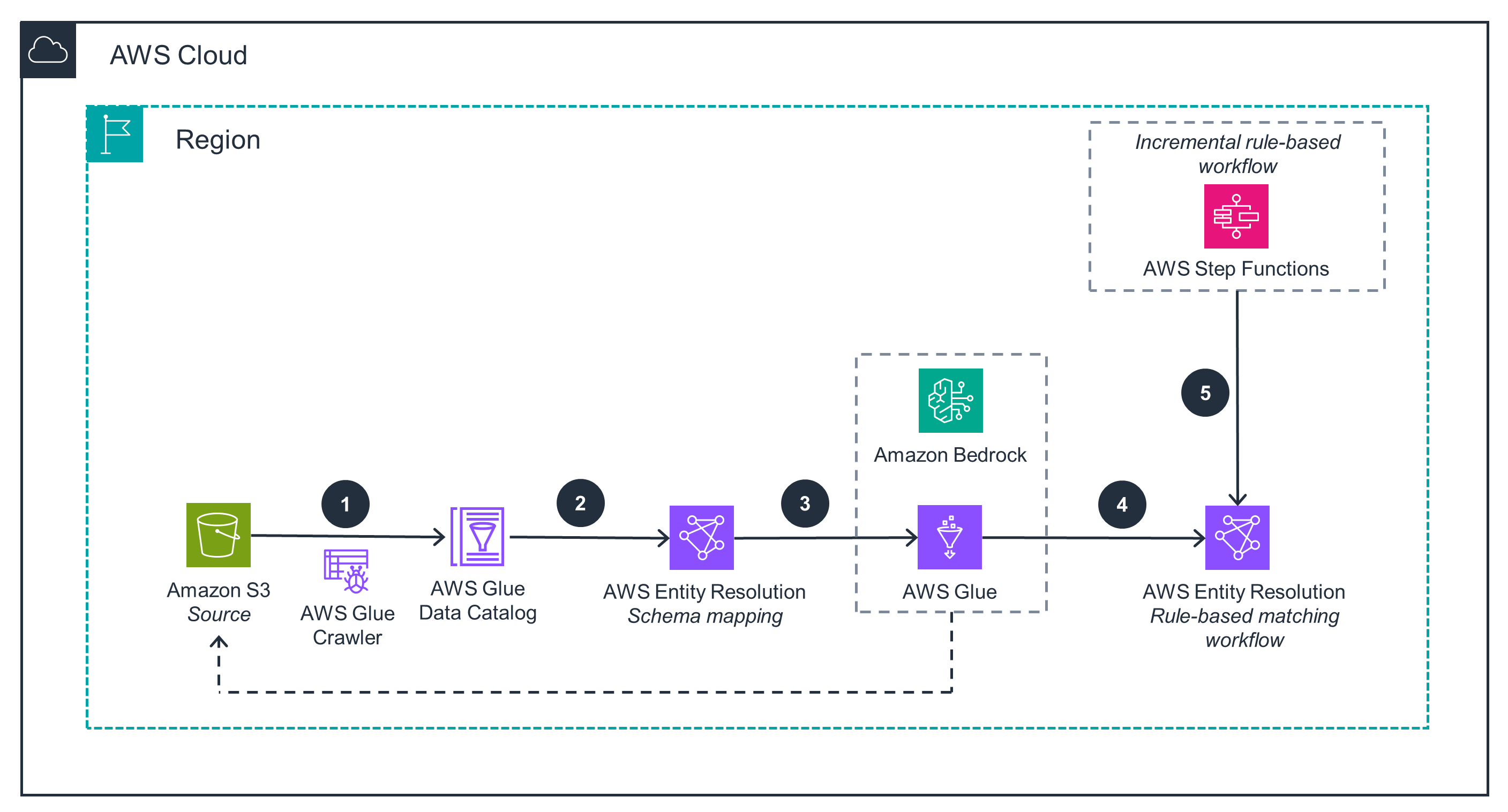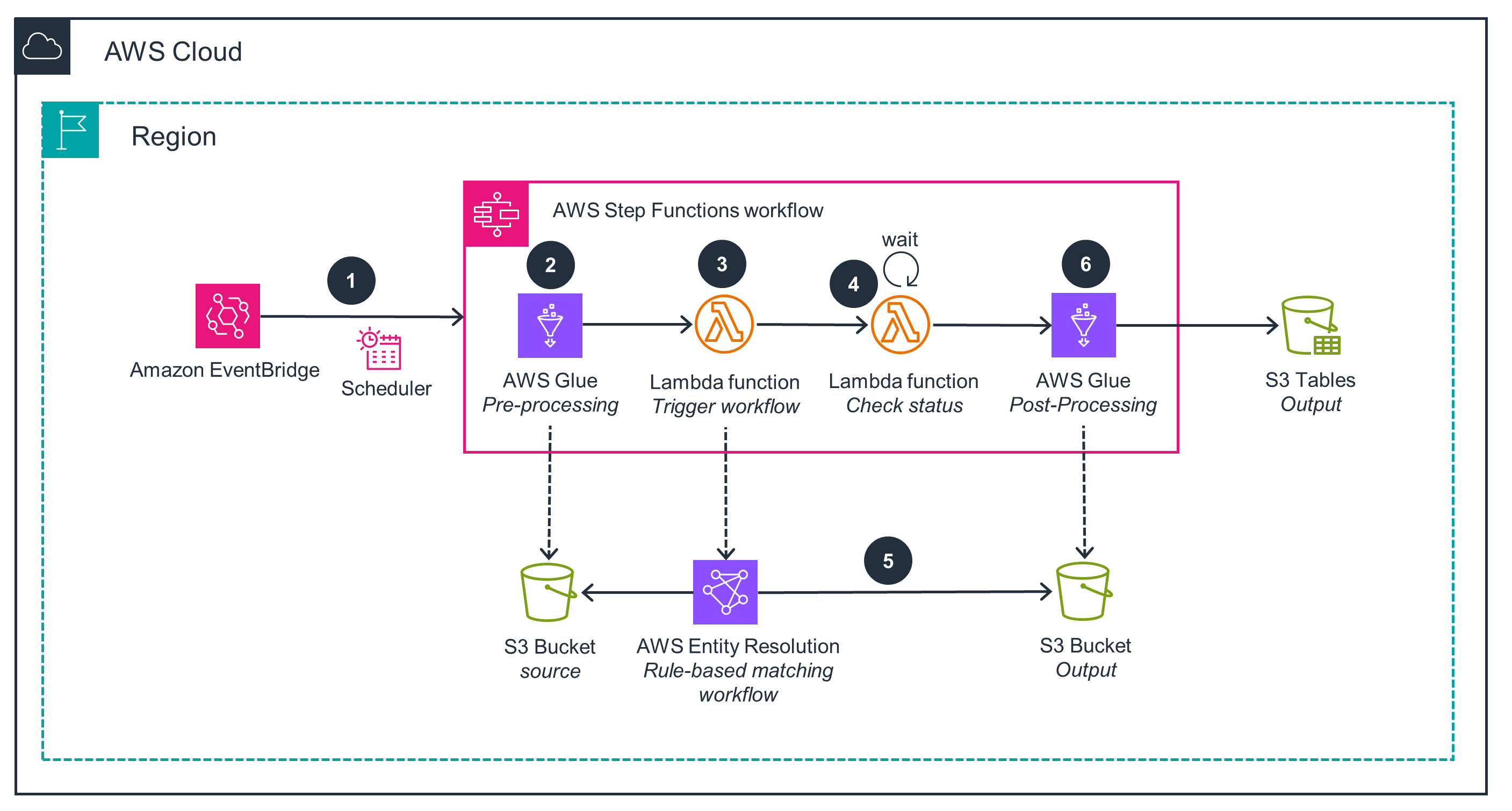- AWS Solutions Library›
- Guidance for Generating Rule Recommendations for Entity Resolution on AWS
Guidance for Generating Rule Recommendations for Entity Resolution on AWS
Overview
This Guidance demonstrates an automated approach for generating rule recommendations to match, link, and enhance related records using AWS Entity Resolution rule-based matching. It showcases an AWS Glue notebook that streamlines the process of creating effective matching rules. The Guidance reads input data from Amazon S3, performs data quality analysis, and harnesses the power of a large language model (LLM) on Amazon Bedrock to produce customized rule recommendations. Each recommendation comes with accompanying reasoning, providing insights into the suggested rules. Furthermore, the Guidance implements a sampling approach to test the generated rules and resolve entities.
How it works
Overview
This architecture diagram shows an overview of how to generate rule recommendations using an LLM hosted on Amazon Bedrock and an AWS Glue notebook and how to use these rules in a rule-based matching workflow in AWS Entity Resolution.

Incremental rule-based workflow
This architecture diagram shows how to run an incremental rule-based matching workflow in AWS Entity Resolution using an AWS Step Functions workflow.

Deploy with confidence
Ready to deploy? Review the sample code on GitHub for detailed deployment instructions to deploy as-is or customize to fit your needs.
Well-Architected Pillars
The architecture diagram above is an example of a Solution created with Well-Architected best practices in mind. To be fully Well-Architected, you should follow as many Well-Architected best practices as possible.
AWS Glue is a managed service that runs workloads and provides monitoring metrics for jobs. It offers fault tolerance with support for retries in case of failures. AWS Glue Crawler automates the discovery of data schematics. These features create a scalable, fault-tolerant system that provides insights into runtime metrics of jobs.
Read the Operational Excellence whitepaperAWS Identity and Access Management (IAM) policies are scoped down to the minimum permissions required for services to function properly. Data stored in Amazon S3 uses encryption at rest. These measures limit unauthorized access to resources and protect data integrity. By implementing tight access controls and encrypting data at rest, the Guidance enhances overall security posture and helps meet compliance requirements.
Read the Security whitepaperAs managed services, AWS Glue, AWS Entity Resolution, Amazon Bedrock, and Step Functions reduce the operational burden of maintaining reliability, allowing the system to recover from failures automatically. These services support retries for recovery from failures and integrate with Amazon CloudWatch to provide operational insights.
Read the Reliability whitepaperAWS Glue offers a serverless architecture that scales compute resources up or down based on workload demands. It provides different instance types for users to choose based on their specific workload requirements. AWS Glue connects with other AWS services through AWS networking services and can run within a virtual private cloud (VPC). This flexibility in resource selection and automatic scaling helps ensure that the system can efficiently handle varying workload intensities.
Read the Performance Efficiency whitepaperThis Guidance uses managed services that follow a pay-as-you-go pricing model, meaning you only pay for the resources you use. AWS Glue is serverless, providing scaling capabilities that help optimize costs. AWS Entity Resolution charges based on the volume of ingested data. Amazon S3 costs depend on data storage and access patterns. Step Functions charges based on the number of state transitions. This usage-based pricing across services helps ensure that costs align closely with actual resource consumption.
Read the Cost Optimization whitepaperAs a serverless service, AWS Glue only consumes resources when actively processing data. It offers features like data partitioning and compression, which reduce storage and compute resource requirements for data processing pipelines. AWS Glue offers automatic scaling based on workload helps optimize resource utilization and reduce energy consumption.
Read the Sustainability whitepaperDisclaimer
Did you find what you were looking for today?
Let us know so we can improve the quality of the content on our pages